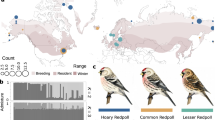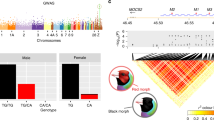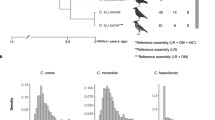Abstract
Animal species display enormous variation for innate behaviours, but little is known about how this diversity arose. Here, using an unbiased genetic approach, we map a courtship song difference between wild isolates of Drosophila simulans and Drosophila mauritiana to a 966 base pair region within the slowpoke (slo) locus, which encodes a calcium-activated potassium channel1. Using the reciprocal hemizygosity test2, we confirm that slo is the causal locus and resolve the causal mutation to the evolutionarily recent insertion of a retroelement in a slo intron within D. simulans. Targeted deletion of this retroelement reverts the song phenotype and alters slo splicing. Like many ion channel genes, slo is expressed widely in the nervous system and influences a variety of behaviours3,4; slo-null males sing little song with severely disrupted features. By contrast, the natural variant of slo alters a specific component of courtship song, illustrating that regulatory evolution of a highly pleiotropic ion channel gene can cause modular changes in behaviour.
This is a preview of subscription content, access via your institution
Access options
Subscribe to this journal
Receive 51 print issues and online access
$199.00 per year
only $3.90 per issue
Buy this article
- Purchase on Springer Link
- Instant access to full article PDF
Prices may be subject to local taxes which are calculated during checkout




Similar content being viewed by others
Accession codes
Change history
17 August 2016
Minor changes were made to Fig. 4a and the main text.
References
Atkinson, N. S., Robertson, G. A. & Ganetzky, B. A component of calcium-activated potassium channels encoded by the Drosophila slo locus. Science 253, 551–555 (1991)
Stern, D. L. Identification of loci that cause phenotypic variation in diverse species with the reciprocal hemizygosity test. Trends Genet . 30, 547–554 (2014)
Becker, M. N., Brenner, R. & Atkinson, N. S. Tissue-specific expression of a Drosophila calcium-activated potassium channel. J. Neurosci. 15, 6250–6259 (1995)
Atkinson, N. S. et al. Molecular separation of two behavioral phenotypes by a mutation affecting the promoters of a Ca-activated K channel. J. Neurosci. 20, 2988–2993 (2000)
Bennet-Clark, H. C. & Ewing, A. W. The courtship songs of Drosophila . Behaviour 31, 288–301 (1968)
Arthur, B. J., Sunayama-Morita, T., Coen, P., Murthy, M. & Stern, D. L. Multi-channel acoustic recording and automated analysis of Drosophila courtship songs. BMC Biol. 11, 11 (2013)
Greenspan, R. J. & Ferveur, J. F. Courtship in Drosophila . Annu. Rev. Genet. 34, 205–232 (2000)
Huttunen, S., Aspi, J., Hoikkala, A. & Schlötterer, C. QTL analysis of variation in male courtship song characters in Drosophila virilis . Heredity 92, 263–269 (2004)
Gleason, J. M., Nuzhdin, S. V. & Ritchie, M. G. Quantitative trait loci affecting a courtship signal in Drosophila melanogaster. Heredity 89, 1–6 (2002)
Turner, T. L., Miller, P. M. & Cochrane, V. A. Combining genome-wide methods to investigate the genetic complexity of courtship song variation in Drosophila melanogaster . Mol. Biol. Evol. 30, 2113–2120 (2013)
Williams, M. A., Blouin, A. G. & Noor, M. A. F. Courtship songs of Drosophila pseudoobscura and D. persimilis. II. Genetics of species differences. Heredity 86, 68–77 (2001)
Stern, D. L. Reported Drosophila courtship song rhythms are artifacts of data analysis. BMC Biol. 12, 38 (2014)
Cande, J., Stern, D. L., Morita, T., Prud’homme, B. & Gompel, N. Looking under the lamp post: neither fruitless nor doublesex has evolved to generate divergent male courtship in Drosophila . Cell Reports 8, 363–370 (2014)
Garrigan, D. et al. Genome sequencing reveals complex speciation in the Drosophila simulans clade. Genome Res . 22, 1499–1511 (2012)
Andolfatto, P. et al. Multiplexed shotgun genotyping for rapid and efficient genetic mapping. Genome Res . 21, 610–617 (2011)
Greenwood, A. K., Wark, A. R., Yoshida, K. & Peichel, C. L. Genetic and neural modularity underlie the evolution of schooling behavior in threespine sticklebacks. Curr. Biol. 23, 1884–1888 (2013)
Weber, J. N., Peterson, B. K. & Hoekstra, H. E. Discrete genetic modules are responsible for complex burrow evolution in Peromyscus mice. Nature 493, 402–405 (2013)
Bassett, A. R. & Liu, J.-L. CRISPR/Cas9 and genome editing in Drosophila . J. Genet. Genomics 41, 7–19 (2014)
Vergara, C., Latorre, R., Marrion, N. V. & Adelman, J. P. Calcium-activated potassium channels. Curr. Opin. Neurobiol. 8, 321–329 (1998)
Stern, D. L. Tagmentation-based mapping (TagMap) of mobile DNA genomic insertion sites. Preprint at http://dx.doi.org/10.1101/037762 (2016)
Brenner, R., Thomas, T. O., Becker, M. N. & Atkinson, N. S. Tissue-specific expression of a Ca2+-activated K+ channel is controlled by multiple upstream regulatory elements. J. Neurosci. 16, 1827–1835 (1996)
Yu, J. Y., Upadhyaya, A. B. & Atkinson, N. S. Tissue-specific alternative splicing of BK channel transcripts in Drosophila . Genes Brain Behav . 5, 329–339 (2006)
Bendesky, A., Tsunozaki, M., Rockman, M. V., Kruglyak, L. & Bargmann, C. I. Catecholamine receptor polymorphisms affect decision-making in C. elegans . Nature 472, 313–318 (2011)
Bendesky, A. et al. Long-range regulatory polymorphisms affecting a GABA receptor constitute a quantitative trait locus (QTL) for social behavior in Caenorhabditis elegans . PLoS Genet . 8, e1003157 (2012)
de Bono, M. & Bargmann, C. I. Natural variation in a neuropeptide Y receptor homolog modifies social behavior and food response in C. elegans . Cell 94, 679–689 (1998)
McGrath, P. T. et al. Quantitative mapping of a digenic behavioral trait implicates globin variation in C. elegans sensory behaviors. Neuron 61, 692–699 (2009)
Osborne, K. A. et al. Natural behavior polymorphism due to a cGMP-dependent protein kinase of Drosophila . Science 277, 834–836 (1997)
Yalcin, B. et al. Genetic dissection of a behavioral quantitative trait locus shows that Rgs2 modulates anxiety in mice. Nat. Genet. 36, 1197–1202 (2004)
Gotz, K. G. Course-control, metabolism and wing interference during ultralong tethered flight in Drosophila melanogaster . J. Exp. Biol. 128, 35–46 (1987)
Broman, K. W., Wu, H., Sen, S. & Churchill, G. A. R/qtl: QTL mapping in experimental crosses. Bioinformatics 19, 889–890 (2003)
Acknowledgements
We thank C. Llorens for advice on retroelement classification and B. Dickson, N. Frankel, T. Shirangi, N. Spruston and S. Sternson for advice on the manuscript.
Author information
Authors and Affiliations
Contributions
Y.D. and D.L.S. designed the experiments. A.B. performed QTL analysis, with help from T.M. Y.D. and K.D.L. assayed wing beat frequency. D.L.S. performed TagMap analysis. Y.D. performed all other experiments and analysis. Y.D. and D.L.S. wrote the manuscript.
Corresponding author
Ethics declarations
Competing interests
The authors declare no competing financial interests.
Additional information
Reviewer Information Nature thanks B. Prud’homme, T. Turner and the other anonymous reviewer(s) for their contribution to the peer review of this work.
Extended data figures and tables
Extended Data Figure 1 QTL analysis of pulse song carrier frequency and inter-pulse interval.
a, Pulse song carrier frequency (mean ± s.d.) in parental strains, F1 hybrids, and backcross males. b, QTL map of pulse song frequency. LOD, logarithm of the odds. Horizontal lines mark P = 0.01. A single QTL on chromosome 3 at 34,919,124 bp was identified in the sim5 backcross (blue). No significant QTL were detected in the mau29 backcross (orange). c, Inter-pulse interval (mean ± s.d.) in parental strains, F1 hybrids, and backcross males. d, QTL map of inter-pulse interval. Two QTLs on chromosome 3 at 7,902,342 bp and 52,144,317 bp were identified in the sim5 backcross (blue). No significant QTL was detected in the mau29 backcross (orange).
Extended Data Figure 2 Details of fine-scale mapping.
a, Sine song frequency of the introgression lines shown in Fig. 2a. b, Genotype and phenotype data of informative recombinant lines. The genotyping markers are listed on the top, according to their physical locations on chromosome 3. For each recombinant line, the genotyping results are represented using coloured bars: blue, homozygote for sim5; orange, heterozygote for sim5 and mauW; and light orange, unknown. For boxed bars, the genotypes were assigned assuming no additional recombination events in this region. The sine song frequency effect is summarized on the right. Line 1_84 was recovered by selecting flies with stronger DsRed and without EYFP. (This strategy was abandoned later due to the challenge of distinguishing two copies of DsRed from one. Please refer to Fig. 2b.) c, Sine song frequency phenotypes of the recombinant lines in panel b. Comparison of sine song frequency (mean ± s.d.) was made between heterozygous introgression males (+) and their pure sim5 sibling brothers (−) using one-way ANOVA. NS, non-significant.
Extended Data Figure 3 Targeted insertion of DsRed markers via CRISPR/Cas9-mediated HDR.
a, b, Schematics of the targeted insertions of the markers 44.95DsRed (a) and 45.12DsRed (b). PAM, protospacer adjacent motif. c, d, PCR validation of 44.95DsRed (c) and 45.12DsRed (d) using the primer sets indicated in the panels above. A heterozygous fly was used for PCR and the negative control (NC) used a fly of the introgression line A2.3. The lower band (arrow) seen with primer set 2 therefore represents the wild-type allele. The PCR fragment containing the DsRed insertion is indicated by the white arrowhead. M, GeneRuler 1 kb DNA ladder.
Extended Data Figure 4 Generation and validation of the slo-null allele sloΔ1.
a, Schematic of the generation of the sim5 and mauW sloΔ1 alleles in the genetic background of the introgression line A2.3. Blue and orange bars represent sim5 and mauW DNA, respectively. Green triangle denotes the EYFP marker. gRNA, guide RNA; ssDNA, single-stranded DNA; DsiRNA, Dicer-substrate short interfering RNA. b, Sequence verification of sloΔ1. Successful integration of ssDNA was confirmed by sequencing the cloned PCR products amplified from a heterozygous fly. Red asterisks indicate the introduced stop codon. PAM, protospacer adjacent motif.
Extended Data Figure 5 Expression pattern and song phenotype of slo.
a, Schematic of the generation of the sloLexA::P65 allele. T2A self-cleavage peptide sequences, LexA::P65, a 120 bp deletion, and a 3XP3::DsRed insertion were introduced into the first common exon shared by all slo transcripts in D. melanogaster. b, Schematic of the generation of the sloΔ2 allele. Two stop codons, a 120 bp deletion, and a 3XP3::DsRed insertion were introduced into the same locus indicated in panel a. The same allele was generated in each of the following D. simulans strains: sim5, sim202, sim203, sim205. PAM, protospacer adjacent motif. c, d, Brain (c) and ventral nerve cord (d) of D. melanogaster LexAop-nls::GFP, sloLexA::P65 males showed widespread expression of slo. e–h, Courtship song phenotype of sim5 sloΔ2 males. The slo-null males produced very little song (e). SinesPerMin and PulsesPerMin measure the average amount of sine song and pulse song produced per minute, respectively. The sine and pulse events of the slo-null males were severely disrupted: sine song waveform (f); pulse train (g); pulse song waveform (h). i, sloΔ2 heterozygotes sang sine song at 9.9 Hz lower frequency than wild-type. Data represent mean ± s.d. P values by one-way ANOVA.
Extended Data Figure 6 Additional song phenotypes of slo hemizygotes.
Blue indicates the genotype mauW–/sim5+ and orange indicates mauW+/sim5−. None of these song phenotypes are significantly different by one-way ANOVA (P > 0.05). Data represent mean ± s.d. The definitions of each song phenotype are as follows: PulseTrainsPerMin, average number of pulse trains per minute; PulsesPerMin, average pulse song duration in seconds per minute; SineTrainsPerMin, average number of sine trains per minute; SinesPerMin, average sine song duration in seconds per minute; BoutsPerMin, average number of song bouts per minute; SongPerMin, average song duration per minute; NullToSine, transition probability from no song to sine song; NullToPulse, transition probability from no song to pulse song; SineToNull, transition probability from sine song to no song; PulseToNull, transition probability from pulse song to no song; SineToPulse, transition probability from sine song to pulse song within song bouts; PulseToSine, transition probability from pulse song to sine song within song bouts; MedianPulseTrainLength, median length of pulse trains; MedianSineTrainLength, median length of sine trains; Sine2Pulse, ratio of amount of sine song to amount of pulse song; Sine2PulseNorm, Sine2Pulse normalized by the amount of song; MedianLLRfh, median score of the log likelihood ratio of fit of pulse to pulse model versus white noise (measure of pulse shape); MedianPulseAmplitudes, median amplitude of pulses; MedianSineAmplitudes, median amplitude of sines; CorrSineFreqDynamics, slope of sine song carrier frequency within song bouts.
Extended Data Figure 7 Sine song frequency phenotypes of 12 D. simulans wild-type isolates (blue) and 12 D. mauritiana wild-type isolates (orange).
Open circles with lines represent mean ± s.d. Closed circles with lines represent mean ± s.d. of the means of all D. simulans (all_sim) and D. mauritiana strains (all_mau). P value by one-way ANOVA. All strains were recorded simultaneously through multiple recording sessions.
Extended Data Figure 8 Targeted deletion of the retroelement insertion at the slo intron in sim5.
a, Putative schematic of the targeted deletion of the retroelement insertion using a two-step strategy. First, the retroelement was replaced by a 3XP3::DsRed marker cassette flanked by PiggyBac transposon ends (labelled as pBac), using CRISPR/Cas9-mediated HDR. This generated the sloRE-DsRed+ allele. Second, the 3XP3::DsRed marker was hopped out of the genome using piggyBac transposase to generate the sloRE− allele. In the first step, two independent HDR events appear to have occurred between the donor plasmids and the slo locus. All three sloRE-DsRed+ alleles we generated support this rare recombination type (data not shown), which possibly reflects the difficulty of repairing a large deletion with a single donor plasmid. PAM, protospacer adjacent motif. b, c, PCR validation of the sloRE-DsRed+ allele (b) and the sloRE− allele (c) using the primer sets indicated in panel a. M, GeneRuler 1 kb DNA ladder. d, Sequence verification of the sloRE− allele. The piggyBac footprint ‘TTAA’ is highlighted.
Extended Data Figure 9 Identification of putative Shellder copies in D. simulans and D. mauritiana populations.
a, Schematic of the Shellder insertion at the slo locus in sim5. Shellder contains three open reading frames (ORFs) resembling the gag, pol, and env genes of a retrovirus, flanked by 458 bp long terminal repeats (LTRs). Putative core protein domains are indicated: PR, protease; RT, reverse transcriptase; RH, RNase H; INT, integrase. In other retroviruses, the pol ORF often includes a 5′ protease domain. Shellder contains a conserved protease domain 5′ of the predicted pol start codon. It is possible that the Shellder pol ORF uses a non-ATG start codon. TSR, target site repeat. P1, P2, and P3 represent the three LTR-specific primers used for TagMap. b, Putative Shellder copies in D. simulans (blue) and D. mauritiana (orange) wild-type strains identified by TagMap. The slo locus insertion in sim5 is indicated and is unique amongst these samples. Shellder insertions are enriched near centromeres (grey ovals), but can also be found in the euchromatic regions. Precise mapping locations are provided in Supplementary Table 5. This is probably an incomplete survey of Shellder copies, because TagMap may be biased towards detecting young and intact copies of transposable elements.
Extended Data Figure 10 Phylogenetic position of Shellder in the Ty3/Gypsy family based on reverse transcriptase protein sequences.
Bootstrap values (%) are indicated on the branches only when they exceed 60. Branch lengths are not drawn proportional to genetic distance.
Supplementary information
Supplementary Information
This file contains Supplementary Methods, Supplementary References and Supplementary Tables 1-5. (PDF 294 kb)
Supplementary Audio 1
This audio file contains one-half second of sim5 sine song repeated 5 times. (WAV 48 kb)
Supplementary Audio 2
This file contains one-half second of mau29 sine song repeated 5 times. (WAV 48 kb)
Courtship song of D. simulans
The male fly extends wing unilaterally and produces two kinds of acoustic signals: the pulse song and the sine song. (MP4 4715 kb)
Rights and permissions
About this article
Cite this article
Ding, Y., Berrocal, A., Morita, T. et al. Natural courtship song variation caused by an intronic retroelement in an ion channel gene. Nature 536, 329–332 (2016). https://doi.org/10.1038/nature19093
Received:
Accepted:
Published:
Issue Date:
DOI: https://doi.org/10.1038/nature19093
This article is cited by
-
Evolutionary conservation and diversification of auditory neural circuits that process courtship songs in Drosophila
Scientific Reports (2023)
-
Flexible neural control of transition points within the egg-laying behavioral sequence in Drosophila
Nature Neuroscience (2023)
-
Origin, evolution, and tissue-specific functions of the porcine repetitive element 1
Genetics Selection Evolution (2022)
-
Evolution of central neural circuits: state of the art and perspectives
Nature Reviews Neuroscience (2022)
-
Integrated transcription factor profiling with transcriptome analysis identifies L1PA2 transposons as global regulatory modulators in a breast cancer model
Scientific Reports (2021)
Comments
By submitting a comment you agree to abide by our Terms and Community Guidelines. If you find something abusive or that does not comply with our terms or guidelines please flag it as inappropriate.



